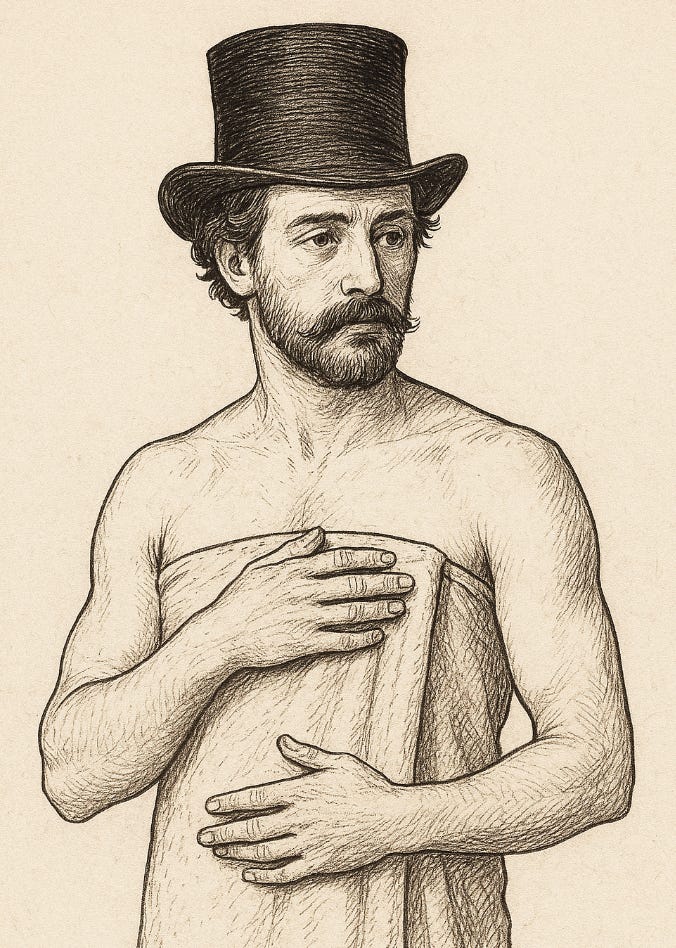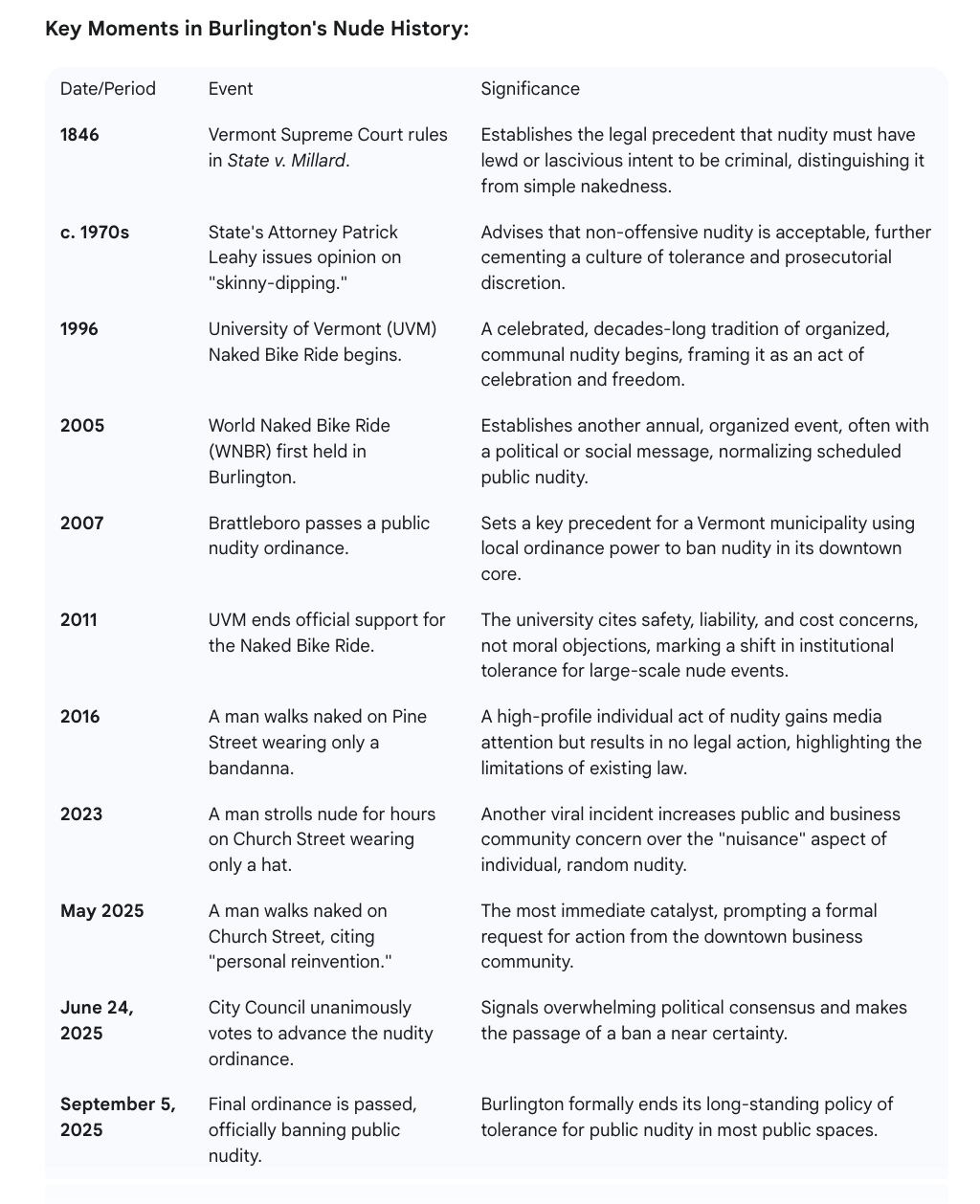After 179 Years, Burlington Ends Public Nudity
The story of Burlington's long-standing tolerance for public nudity begins not with sunbathers or protest, but with an act of genuine depravity in Orleans County.
For nearly two centuries, a quirk of Vermont law, born from an 1846 Supreme Court ruling, allowed public nudity to persist in the Green Mountain State. This legal oddity, a source of both pride and consternation, became a defining feature of Burlington's counter-cultural charm. Yet, in the waning months of 2025, the Queen City's era of widespread public nakedness quietly came to an end. It was not a moral panic, but a pragmatic response to evolving social norms and economic pressures, drawing a definitive line under a tradition stretching back to a man named J. Millard and his unsavory intentions.
The Original Pervert: State v. Millard (1846)
The story of Burlington's long-standing tolerance for public nudity begins not with sunbathers or protest, but with an act of genuine depravity in Orleans County. In 1846, a man named J. Millard was brought before the Vermont Supreme Court. According to court documents, Millard had repeatedly exposed himself to a woman in her home, physically grabbing her and pressuring her for sex.
Millard's defense, perhaps surprisingly, hinged on a technicality: he argued his actions couldn't be considered "open and gross lewdness" because they occurred inside a private home, witnessed only by one person. The Supreme Court, however, swiftly dismissed this narrow interpretation. They ruled that "open" simply meant "undisguised, not concealed," and that the number of witnesses was irrelevant.
Crucially, the court's decision in State v. Millard didn't criminalize nudity itself. Instead, it focused on Millard's intent. The justices determined he wasn't merely naked; he was a "pervert" acting "with intent to incite in their minds lewd and unchaste desires." His conduct, they concluded, was about "exciting unchaste feelings and passions," not innocent self-expression. This ruling established a bedrock principle in Vermont law: public nudity was not illegal unless it was accompanied by a clear, provable "lewd and lascivious" intent. This high bar for prosecution would shape Vermont's unique stance on public nakedness for the next 179 years.
A Culture of Tolerance Takes Root
In the decades that followed Millard, Vermont cultivated an environment where simple public nudity, devoid of lewd intent, often went unchallenged. This wasn't necessarily a state-sanctioned endorsement of disrobing, but rather a consequence of the law's narrow focus. As far back as the 1970s, as reported by the Burlington Free Press, then-Chittenden County State's Attorney Patrick Leahy advised that "skinny-dipping" was acceptable "if no member of the public present is offended, no disorderly conduct has taken place." This advice further solidified a culture of prosecutorial discretion and tolerance.
Burlington, with its progressive ethos and counter-cultural leanings, became a natural haven for this legal ambiguity. The city's reputation for quirky individuality embraced forms of public nudity that would raise eyebrows elsewhere.
Two Kinds of Naked: Organized vs. Opportunistic
For decades, Burlington's public nudity was largely contextual. The UVM Naked Bike Ride, beginning in 1996, became a beloved biannual tradition, described by students as a "celebration" and a way to "blow off steam," according to news reports. Similarly, the World Naked Bike Ride, first held in Burlington in 2005, often carried a message about cycling safety or body positivity. These were organized, predictable events, part of the city's unique fabric. Even when UVM ended its official support for its ride in 2011, it cited safety and cost concerns, not moral objections.
However, a different kind of nudity began to emerge, shifting public perception. Incidents in 2016, 2023, and most notably in May 2025, involved lone individuals walking nude in highly public and commercial areas like Church Street, often citing personal freedom or "reinvention." These were not organized events, but spontaneous acts.
Public sentiment began to shift. Residents, according to local news, described these individual acts not as celebration, but as a "fetish" being imposed on an unwilling public. Comments often distinguished between the "quirky" bike rides and what some saw as "flaunting it/look at me displays" or "exhibitionism." This distinction was crucial: it moved the conversation from counter-cultural expression to public nuisance.
The Business Community Steps In
The turning point came as Burlington's downtown businesses faced increasing struggles. The Burlington Business Association (BBA), as confirmed by its representative Kelly Devine, formally communicated with the City Council. The BBA's letter, widely reported by local media, stated, "We have observed an increasing trend of individuals engaging in deliberately inappropriate behavior in public spaces, which is causing alarm among families and negatively impacting Burlington's reputation as a welcoming environment."
This provided the City Council with a powerful, pragmatic reason to act. The argument was no longer solely about morality or freedom of expression; it was about economic stability, public safety, and the city's image as a family-friendly destination.
The Legislative Endgame: A "No-Brainer" Ordinance
With mounting pressure from businesses and residents who reported feeling uncomfortable, particularly with children in tow, the City Council moved swiftly. On June 24, 2025, the council voted unanimously to advance amendments to the city's public nudity ordinance. This unanimity was a clear signal: the political will for change was overwhelming.
City Council President Ben Traverse, speaking to local media, framed the ordinance as a "no-brainer" and a necessary step to find a "fine balance between protecting folks' right to free expression as well as that level of indecent exposure that really is a public nuisance." He also pointed out that other Vermont communities, like Brattleboro in 2007, had already implemented similar bans, indicating that Burlington was merely catching up.
The final ordinance, passed on September 5, 2025, officially banned public nudity in non-designated areas and carried a penalty of up to $500. It meticulously targeted the areas of concern—downtown streets, areas near schools—while acknowledging that non-sexual nudity might still be permissible in very specific, designated locations, though few such places now exist.
The End of an Era
Burlington's journey from State v. Millard to its 2025 nudity ban is a fascinating illustration of how a legal technicality, combined with a unique cultural spirit, can shape a city's identity for generations. The end of widespread public nudity in Burlington wasn't a sudden reversal of values. Instead, it was a practical adjustment to changing times, as individual acts of public nakedness transformed from a quirky local tradition into a perceived public nuisance and an economic detriment. The pervert from 1846 and the modern-day exhibitionist ultimately converged to end a long-standing, if often debated, aspect of Burlington's distinct character.





It is a shame that a few may ruin it for all !
I read that the law even required one to leave their house naked rather than disrobe. This seems a complete 180.